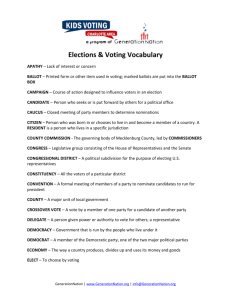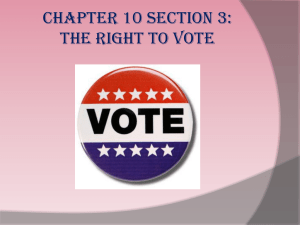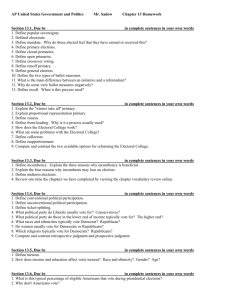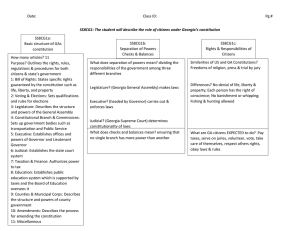AP Government - Cloudfront.net
advertisement
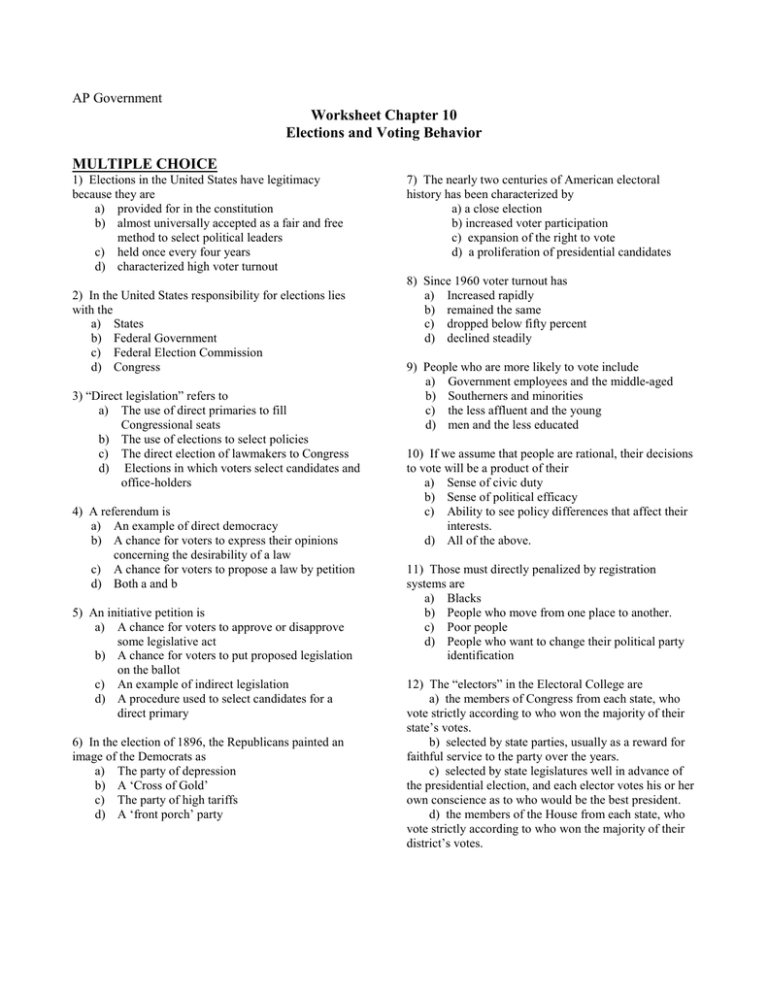
AP Government Worksheet Chapter 10 Elections and Voting Behavior MULTIPLE CHOICE 1) Elections in the United States have legitimacy because they are a) provided for in the constitution b) almost universally accepted as a fair and free method to select political leaders c) held once every four years d) characterized high voter turnout 2) In the United States responsibility for elections lies with the a) States b) Federal Government c) Federal Election Commission d) Congress 3) “Direct legislation” refers to a) The use of direct primaries to fill Congressional seats b) The use of elections to select policies c) The direct election of lawmakers to Congress d) Elections in which voters select candidates and office-holders 4) A referendum is a) An example of direct democracy b) A chance for voters to express their opinions concerning the desirability of a law c) A chance for voters to propose a law by petition d) Both a and b 5) An initiative petition is a) A chance for voters to approve or disapprove some legislative act b) A chance for voters to put proposed legislation on the ballot c) An example of indirect legislation d) A procedure used to select candidates for a direct primary 6) In the election of 1896, the Republicans painted an image of the Democrats as a) The party of depression b) A ‘Cross of Gold’ c) The party of high tariffs d) A ‘front porch’ party 7) The nearly two centuries of American electoral history has been characterized by a) a close election b) increased voter participation c) expansion of the right to vote d) a proliferation of presidential candidates 8) Since 1960 voter turnout has a) Increased rapidly b) remained the same c) dropped below fifty percent d) declined steadily 9) People who are more likely to vote include a) Government employees and the middle-aged b) Southerners and minorities c) the less affluent and the young d) men and the less educated 10) If we assume that people are rational, their decisions to vote will be a product of their a) Sense of civic duty b) Sense of political efficacy c) Ability to see policy differences that affect their interests. d) All of the above. 11) Those must directly penalized by registration systems are a) Blacks b) People who move from one place to another. c) Poor people d) People who want to change their political party identification 12) The “electors” in the Electoral College are a) the members of Congress from each state, who vote strictly according to who won the majority of their state’s votes. b) selected by state parties, usually as a reward for faithful service to the party over the years. c) selected by state legislatures well in advance of the presidential election, and each elector votes his or her own conscience as to who would be the best president. d) the members of the House from each state, who vote strictly according to who won the majority of their district’s votes. 13) Electors in each state cast their votes a) In proportion to the popular vote. b) According to private conscience and personal choice. c) For the candidate who won more than 50 percent of the vote in their state d) For the winner in that state regardless of the distribution of the popular vote. 14) A president is elected by winning a) At least 50 percent of the popular vote b) More than 50 percent of the states c) Majority in the Electoral college d) A majority in the state primaries 15) If a presidential candidate does not receive a majority of electoral college votes, then the president is chosen a) By popular vote b) By the Justices of the Supreme Court c) By the House, one state, one vote d) By the Senate, one state, two votes 16) An effect of the Electoral College system is that it tends to favor a) More populous states with larger cities b) More rural states with larger land areas. c) An elitist view of voter representation. d) Its own choice over a popular majority 17) To elite theorist the purpose of elections is to a) Provide symbolic reassurance to the masses. b) Provide needed information on current policy issues. c) Help shape public policy d) Provide a legitimate means for political participation 18) The belief that there are too many elections and elected official for individual voters to make much difference in policy is part of the a) Democratic theory b) Pluralist theory c) Hyperpluralist d) Elitist theory 19) The relationship between elections and public policy is that a) Elections have no impact on policy in that the parties rarely take a clear stand on issues. b) When the parties and candidates offer a genuine choice, election results do affect policy. c) More issues than could ever be considered on the policy agenda are raised during an election d) All elections constitute a clear mandate for change True and False Questions: There are FIVE false answers. 20) Elections in the US, Japan, and Great Britain are almost universally accepted as a fair and free method to select political leaders 21) Through initiatives and referendums, votes in the states can make public policy directly, bypassing the legislature. 22) The election of 1796 had no primaries, no nominating convention, no campaign, no reporters, and no speeches. 23) As the right to vote has been extended to more and more Americans, proportionally more and more of those eligible to vote have chosen to exercise that right. 24) Among all factors affecting voter turnout, income and sex are the most significant. Middle-aged voters tend to vote more than neither the young of the old. 25) 26) According to Downs, a rational person would decide not to vote I he or she could see no difference between the parties or candidates on policy positions. 27) A rational voter will vote out of a sense of civic duty even if he or she does not have a strong sense of political efficacy. 28) States that make it difficult for people to register to vote tend to have lower voter turnout for elections. 29) Those most directly penalized by registration systems are people who move from one place to another. 30) Since the 1950’s, there has been and upsurge in ticket splitting. 31) In people’s voting decisions, party identification is more important than the evaluati9on of candidates and their stands on issues. 32) Poll predictions are so accurate that only in the very closest elections should a candidate be under any illusion about the outcome. 33) In every state, there is a winner-take-all system of casting Electoral College votes. 34) One of the advantages of the electoral college system is that it is equally representative of all the states as well the full range of American demographic distributions. 35) According to Democratic theory, elections accomplish two tasks: the selection of policymakers and the shaping of public policy. 36) According to elite theorists, elections serve primarily as symbolic reassurance for the masses, while according to democratic theorists, elections are crucial in helping the masses influence public policy. 37) Pluralists are likely to agree with the mandate theory of elections, which sees elections as mandates from the voters tot change public policy according to the winner’s policy positions. FILL IN 38) Elections in the US have _______________ because they are almost universally accepted as a fair and free method to select political leaders. 39) States use ____________________ primaries to select candidates for the US Senate, the House of Representatives, governorships, and other state offices. 40) ____________________ is a form of direct legislation in which voters can put a proposed law directly on a ballot and vote it into policy. 41) ____________________ is a form of direct legislation in which voters can approve or disapprove a law passes by the state legislature. 42) ____________________ is the legal right to vote. 43) Among all factors affecting turnout, ___________________ is the most important. 44) People who vote because they believe that elections are important to democracy are said to have a sense of ____________________. 45) People who vote because they believe one vote can make a difference and their vote matters are said to have a strong sense of ________________. 46) States adopted ________________ systems partly to prevent corruption associated with the buying votes or ‘voting tombstones.’ 47) The ________________ lets politicians justify what they want to do by claiming that an electoral groundswell is behind them. 48) Voting for one party’s candidate for president and another part’s candidate for senator is an example of __________________. 49) __________________ occurs when voters make their choices by evaluating the match between their own issue positions and those of the candidates and parties. 50) A survey of voters’ choices just after they have finished voting is called an _________________. 51) The ________________ is the institution through which an American president is elected. 52) According to ________________, elections provide mainly symbolic reassurance to the masses. Chapter 10 Worksheet 1) B 11) B 2) A 12) B 3) B 13) D 4) D 14) C 5) B 15) C 6) A 16) A 7) C 17) A 8) D 18) C 9) A 19) B 10) D FALSE ANSWERS: 23,24,33,34,37 38) 39) 40) 41) 42) 43) 44) 45) legitimacy direct initiative referendum suffrage SES civic duty political efficacy 46) 47) 48) 49) 50) 51) 52) registration mandate theory of elections ticket splitting Policy voting exit poll electoral college elitists COMPARE AND CONTRAST THE FOLLOWING: 53) initiatives, referendums, and direct democracy 54) primaries, direct primaries, electoral college 54) Voter registration and Motor Voter Act 55) political efficacy and civic duty 56) mandate theory of elections, policy voting, and retrospective voting



